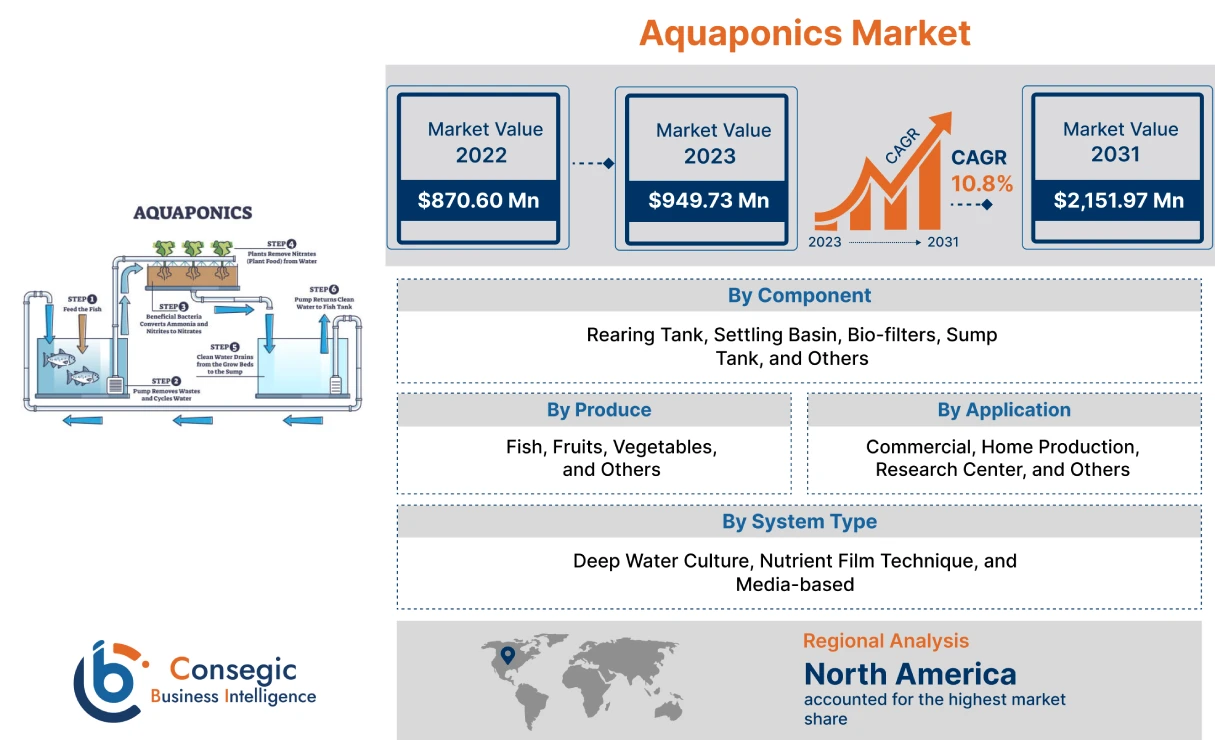Aquaponics Market Size :
Consegic Business Intelligence analyzes that the aquaponics market size is growing with a CAGR of 10.8% during the forecast period (2023-2031), and the market is projected to be valued at USD 2,151.97 Million by 2031 and USD 949.73 Million in 2023 from USD 870.60 Million in 2022.
Aquaponics Market Scope & Overview:
Aquaponics is a way to grow fish and plants together in a closed-loop system. The fish waste provides nutrients for the plants, and the plants clean the water for the fish. The systems can be scaled up or down to meet the needs of individual farmers or businesses. As per the analysis, this makes it a viable option for both commercial and backyard farming. All aquaponic systems consists of several common and essential components. These include a fish tank, a mechanical filter, a biofilter, and hydroponic containers. All systems use energy to circulate water through pipes and plumbing while aerating the water.
Aquaponics Market Insights :
Aquaponics Market Dynamics - (DRO) :
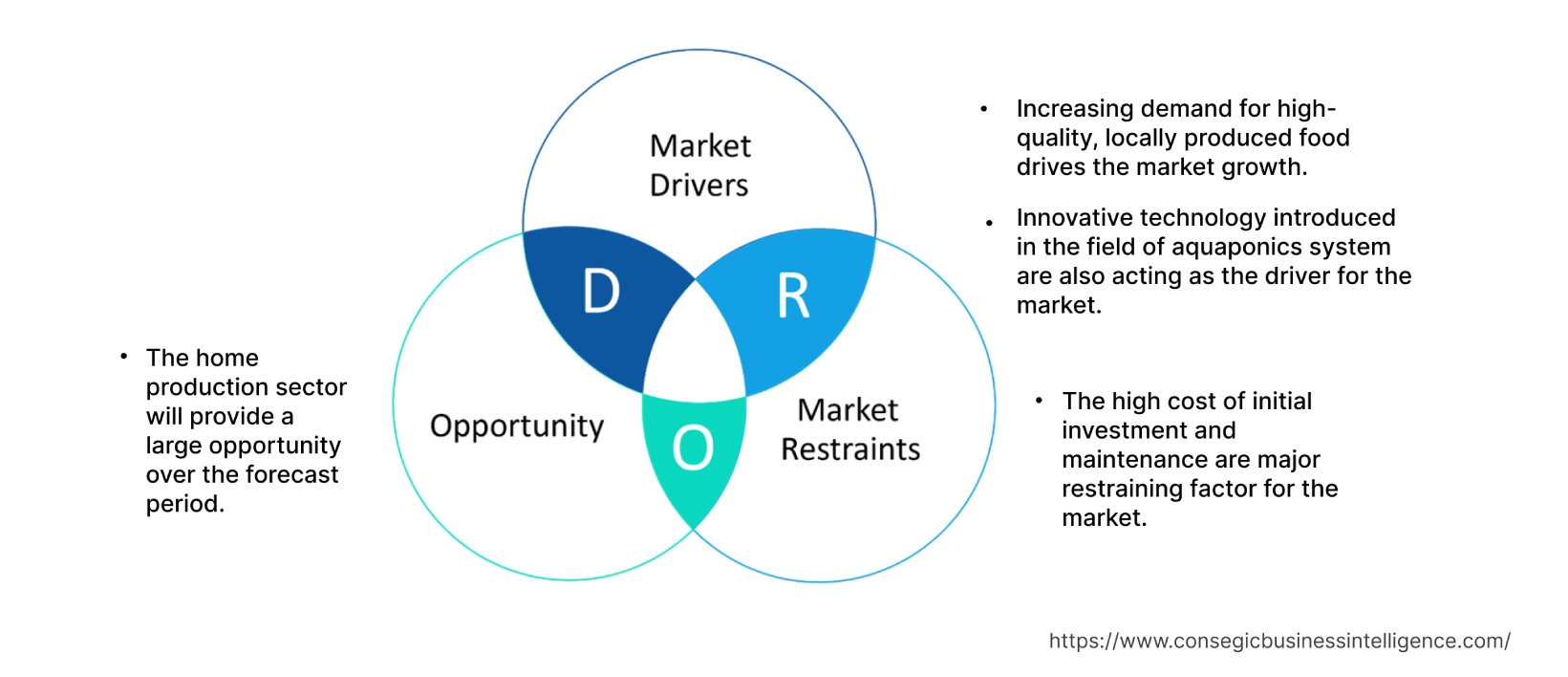
Key Drivers :
Increasing demand for high-quality, locally produced food drives the market growth
Aquaponics is a sustainable food production system that can be used to produce high-quality, locally produced food. The systems combine aquaculture (the cultivation of aquatic organisms like fish) with hydroponics (the growing of plants in nutrient-rich water without soil). The systems can be located in urban areas, as they do not require a lot of space. This makes it possible to produce fresh, local food even in areas where traditional farming is not possible.
Local foods represent a small but growing share of the U.S. food system one reflection of consumers' increasing influence on food production. Local food producers sell their goods directly to consumers at places such as farmers markets, on-farm stores, or pick-your-own stores.
Moreover, based on the analysisEurope holds one of the largest organic farmland areas globally. As a result of the underlying scope for aquaponic farming in the organic produce industry, the European-funded COST Action FA1305, "The European Union Aquaponics Hub-Realising Sustainable Integrated Fish and Vegetable Production for the EU", strengthened the network between researchers and private players. Therefore, the demand for organically grown produce is expected to drive the global aquaponics industry during the forecast period.
Innovative technology introduced in the field of these system are also acting as the driver for the market
Aquaponics is an innovative, smart, and sustainable agricultural technology that integrates aquaculture with hydroponics in growing vegetable crops symbiotically. The application of smart systems in agriculture is known as precision agriculture (PA), which aims to gather, process, and analyze temporal, spatial, and plant morphological features and combine them with other available information to support management decisions for optimizing growth inputs and preserving resources in terms of water and nutrients. As per the analysis, the procedure includes this feature and can be adopted as a precision technology if it is monitored and controlled by modern technologies. Thus, innovative technology introduced in the field of these systems drives aquaponics market growth and trends.
Key Restraints :
The high cost of initial investment and maintenance are major restraining factor for the market
The high price of establishing an indoor or outdoor aquaponics cultivation system is a major barrier for new entrants in the market. Depending on the level of technology used, a greenhouse can cost around two to 20 times more than that required for a conventional soil-based growing system. As per the analysis, the additional cost of this cultivation is due to the need for control and automation systems along with the necessity of expert advice and consultation. For instance, In India, the overall cost of setting up and maintaining a medium-scale greenhouse is currently around USD 376.50 million which is more than the investment needed for a traditional farming setup. For this reason, the high cost of initial investment and maintenance are major restraining factor for the market trends.
Future Opportunities :
The home production sector will provide a large opportunity over the forecast period
The development in the demand for organic food with lower manufacturing costs surges the demand for the home production segment creating lucrative aquaponics market opportunities and trends in the coming years. Besides development in the backyard production of fruits and vegetables due to the rise in health awareness is the other factor for the development of the aquaponics market. Growing food prices in everyday life are generating the opportunity for the growth of home production in the aquaponics market. For instance, according the data published in the journal of agronomy, in February 2023, stated that, a micro-scale aquaponic system in homes can provide part of a healthy and balanced diet, with enough vegetables and fish for an adult Thus, the food production segment is predicted to grow at a significant CAGR during the forecast period due to development in urban farming and increasing demand for fish is further driving the growth and opportunities of the aquaponics market trends.
Aquaponics Market Report Insights :
| Report Attributes | Report Details |
| Study Timeline | 2017-2031 |
| Market Size in 2031 | USD 2,151.97 Million |
| CAGR (2023-2031) | 10.8% |
| By Produce | Fish, Fruits, Vegetables, and Others |
| By System Type | Deep Water Culture, Nutrient Film Technique, and Media-based |
| By Component | Rearing Tank, Settling Basin, Bio-filters, Sump Tank, and Others |
| By Application | Commercial, Home Production, Research Center, and Others |
| By Region | North America, Europe, Asia-Pacific, Latin America, and Middle East & Africa |
| Key Players | Nelson and Pade Aquaponics, Pentair Aquatic Eco-System, Inc., The Aquaponic Source, Hydrofarm Holdings Group, Inc., Practical Aquaponics (Pty) Ltd., Greenlife Aquaponics, Backyard Aquaponics Pty Ltd., My Aquaponics, Aquaponic Lynx LLC, and Aquaponik Manufactory GmbH. |
Aquaponics Market Segmental Analysis :
By Produce :
The produce segment is categorized into fish, fruits, vegetables, and others. In 2022, the fish segment accounted for the highest aquaponics market share of 53.44% in the aquaponics market. Also, it is expected to grow at the fastest CAGR over the forecast period. Increasing the usage of fish species in the these system is the key factor responsible for the growth of the market. The system involves cultivating plants in water in a symbiotic environment. In this organic setting evacuation of aquatic animals such as fish, snails, prawns, or crayfish are manufactured by hydroponic system benefits the market by reducing the production cost with low wastage which increases aquaponics market demand and trends in the forecast year.
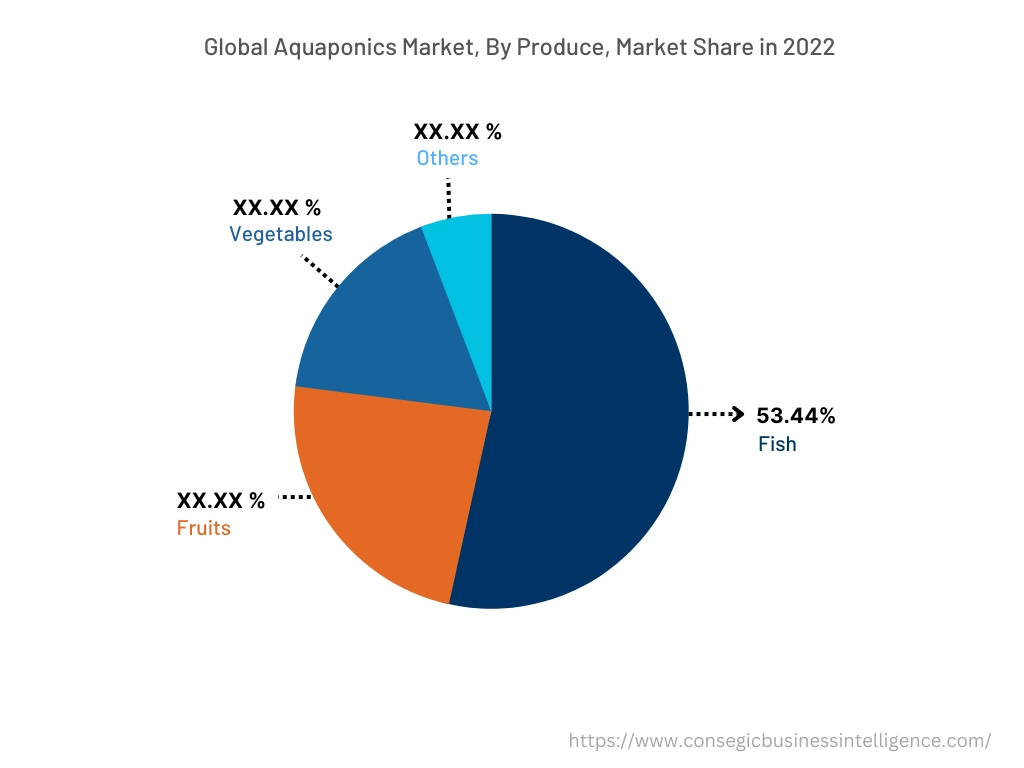
By System Type :
The system type segment is categorized into deep water culture, nutrient film technique, and media-based. In 2022, the media-based segment accounted for the highest market share in the overall aquaponics market. The media-filled grow beds are a simple and inexpensive type of these system. Media-filled bed units are the most popular design for small-scale systems. As per the analysis, the media beds support several fruit and vegetable plants with large root masses. However, this method is not space-efficient and also requires a high amount of labor. These factors are boosting the market trends.
However, the nutrient film technique segment is expected to be the fastest-growing segment over the forecast period due to its space-efficient design and low labor costs. Moreover, it is a hydroponic growing technique adapted to these systems because of its simple and effective design that works well in some environments.
By Component :
The component segment is categorized into rearing tanks, settling basins, bio-filters, sump tanks, and others. In 2022, the rearing tank segment accounted for the highest market share in the overall aquaponics market. Various types of rearing tanks are used in these systems. Even a small aquarium can be used for home-based units. Glass tanks, plastic tanks, rubber maid stock tanks, plastic tanks, and intermediate bulk container totes are several types of rearing tanks or fish tanks.
However, the bio-filters segment is expected to be the fastest-growing segment over the forecast period. Bio-filters in these system converts ammonia into nutrient for plants. It is made by filling a container with bio media which increases the surface area for nitrifying bacteria. Although bio-filters are not an absolute necessity for these systems, their usage improves the efficiency of these systems and is thus installed religiously. Thus, the aforementioned factors are propelling the segment trends.
By Application :
The application segment is categorized into commercial, home production, research center, and others. In 2022, the commercial segment accounted for the highest market share in the overall aquaponics market. Commercial growers widely adopt aquaculture to produce vegetables and different breeds of fish. The dual production of fish and plants obtained in aquaculture is improving its adoption among commercial growers. Several types of fish, such as tilapia, bass, trout, carp, catfish, koi, fingerlings, and different ornamental fishes, can be reared in aquaculture.
However, the research center segment is expected to be the fastest-growing segment during the forecast period. They are valuable tools for research centers in the fields of agriculture, horticulture, and plant biology. Research centers require these systems to conduct experiments by manipulating growing conditions, temperature, humidity, light, and nutrient levels. In-house systems allow researchers to manipulate these factors and test hypotheses about the impact of different environmental conditions on plant growth, yield, and quality.
By Region :
The regional segment includes North America, Europe, Asia Pacific, the Middle East and Africa, and Latin America.
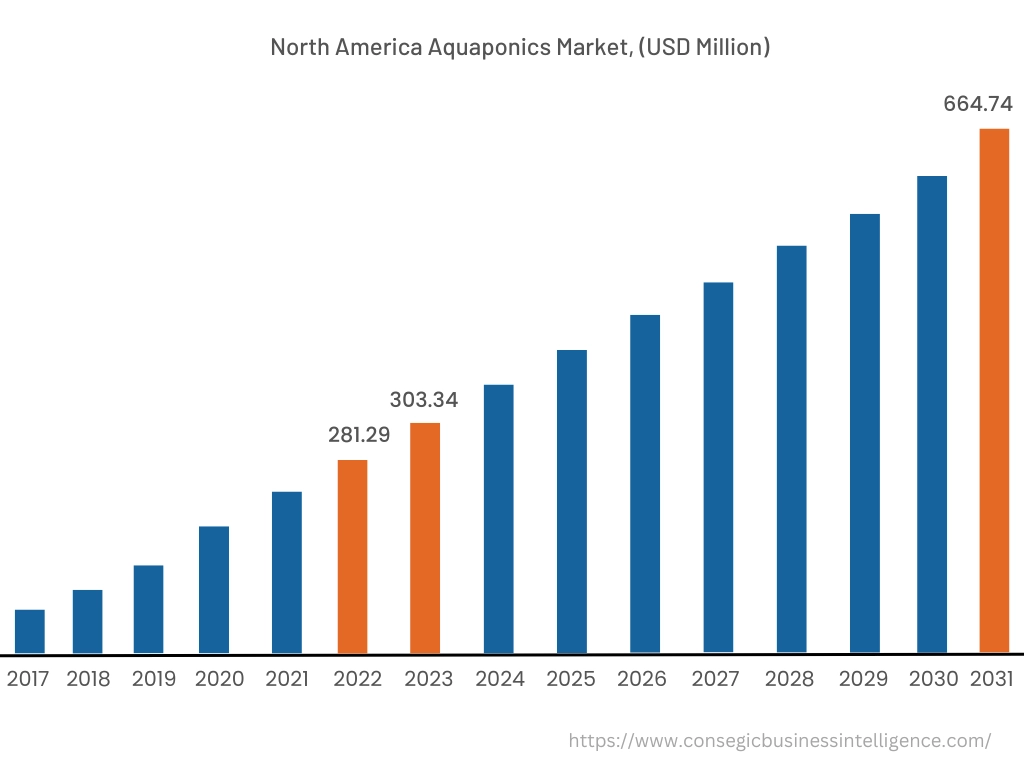
In 2022, North America accounted for the highest market share at 32.31% valued at USD 281.29 million in 2022 and USD 303.34 million in 2023, it is expected to reach USD 664.74 million in 2031. In North America, the U.S. accounted for the highest market share of 88.30% during the base year of 2022. Based on the aquaponics market analysis, it is a small but quickly increasing industry in the region, with various partnerships among educational and research institutions and private companies. This factor played a key role in developing and growing awareness regarding aquaponic farms.
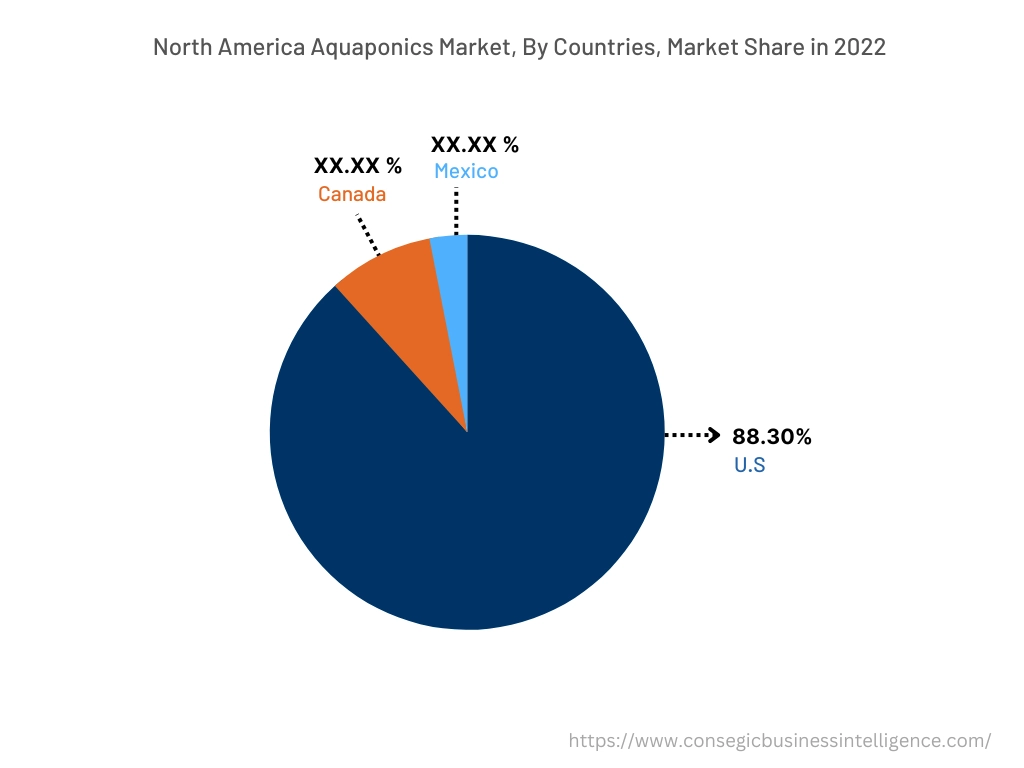
Furthermore, the Asia Pacific is expected to witness significant growth over the forecast period, growing at a CAGR of 12.2% during 2023-2031. This is due to the strong government support for sustainable farming in agricultural countries including India, China, and Southeast Asian countries. The Indian government provides subsidies up to 50% under its several schemes, including the National Horticulture Mission (NHM), which mainly focuses on constructing vertical farms across the country. Numerous state governments in the country are offering an additional 10-15% subsidies for the implementation of modern technologies in the agriculture sector.
Top Key Players & Market Share Insights:
The global aquaponics market is highly competitive, with several large players and numerous small and medium-sized enterprises. These companies have strong research and development capabilities and a strong presence in the market through their extensive product portfolios and distribution networks. The market is characterized by intense competition, with companies focusing on expanding their product offerings and increasing their market share through mergers, acquisitions, and partnerships. The key players in the aquaponics industry include-
- Nelson and Pade Aquaponics
- Pentair Aquatic Eco-System, Inc.
- My Aquaponics
- Aquaponic Lynx LLC
- Aquaponik Manufactory GmbH
- The Aquaponic Source
- Hydrofarm Holdings Group, Inc.
- Practical Aquaponics (Pty) Ltd.
- Greenlife Aquaponics
- Backyard Aquaponics Pty Ltd.
Recent Industry Developments :
- In 2022, Greenlife Aquaponics and Red Ewald, created a mini firm to install Aquaponics equipment that will be useful not only for breeding fishes and plants simultaneously but also create a market that will attract a considerable number of consumers.
- In April 2021, France-based indoor farming company Les Nouvelles Fermes raised approximately USD 2.4 million in its first round of funding from investors from IRDI, the Banque des Territoires, Crédit Agricole Aquitaine, and the CIC. With this funding, the company plans to build the largest aquaponic farm in Europe.
Key Questions Answered in the Report
What was the market size of the aquaponics industry in 2022? +
In 2022, the market size of aquaponics was USD 870.60 million.
What will be the potential market valuation for the aquaponics industry by 2031? +
In 2031, the market size of aquaponics will be expected to reach USD 2,151.97 million.
What are the key factors driving the growth of the aquaponics market? +
Increasing demand for high-quality, locally produced food drives the market growth.
What is the dominating segment in the aquaponics market by Produce? +
In 2022, fish accounted for the highest market share of 53.44% in the overall aquaponics market.
Based on current market trends and future predictions, which geographical region is the dominating region in the aquaponics market? +
North America accounted for the highest market share in the overall aquaponics market.
